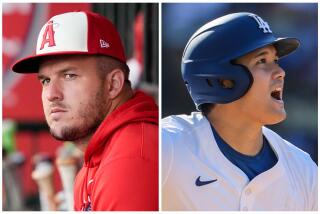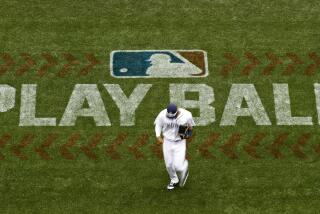COMMENTARY : Fans Take Themselves Out at Old Ballgames
- Share via
WASHINGTON — Turned off by the seemingly greed-driven stalemate that resulted in the cancellation of last fall’s World Series and a shortened 1995 season, major league baseball fans are striking back dramatically with a show of anger and apathy. All but two of the 28 major league teams--the Detroit Tigers and Boston Red Sox--are suffering a drop in attendance, some precipitous, as games are being played before seas of empty seats.
The Texas Rangers’ attendance was down 349,813 after 25 home games, the Atlanta Braves’ 344,370 after 23 dates and the San Francisco Giants’ 285,646 after 23 dates. Even the Baltimore Orioles, who have the best average attendance in the American League, were down 151,727 after 19 home games.
Through Thursday, overall attendance at major league games is down 21 percent--a much greater impact than acting baseball commissioner Bud Selig and many owners expected.
“There’s no question, it’s more severe than we had thought,” said Selig, owner of the Milwaukee Brewers. “This is something that the individual clubs have been addressing.
“It involves the cooperation of the clubs and the players, building a relationship with the fans. And this has to be an ongoing thing. It’s not a one-week or one-month thing. It has to go on forever.”
After a strike of nearly eight months and fruitless debate between owners and players, “fans have shown that they can’t be taken for granted,” said Ed Bunker of Baltimore, who formed a group called “Fan Out America.” “They’ve shown their stuff, whether as part of an organization or by themselves.”
When he formed his group in February, Bunker called for a “limited response” by fans, urging them to stay away from major league ballparks for seven home dates.
But Bunker met resistance when he tried to round up his 350-member group to return to Oriole Park at Camden Yards for the Orioles’ eighth home game. “I had a hard time getting people to come,” he said. “One of them said, ‘I can’t go to baseball yet. I’m still angry.’ Some even renounced ‘Fan Out America’ because we went back.”
Discounted tickets, special attractions and making players available for autographs is not enough, Selig said. He said “central baseball”--major league baseball as a whole--intended to take action to repair the damaged fan support. Declining to be specific, Selig said, “There will be several announcements as the summer goes on” of actions intended to lure fans back.
Owners have announced changes, to take effect next month, they hope will speed games, including preventing hitters from routinely stepping out of the batter’s box between pitches and reducing time between half-innings.
The owners hope to announce plans to alter the skylines in several cities with new baseball-only stadiums modeled on Camden Yards (with the cities helping to pay). The franchises eager to modernize (and thus attract fans) include California, Detroit, Milwaukee, Minnesota, Pittsburgh, San Francisco, Seattle and Boston.
The Pittsburgh Pirates, who rank last in attendance, estimate a loss of $13 million to $20 million this season. Even wealthy teams are having major problems--attendance in Atlanta being far off even though the Braves have one of the most talented teams in baseball, and “no-shows” at Fulton County Stadium have been rampant.
“I had three guys say they didn’t want tickets because of the strike,” said Craig Lindsay of Severna Park, Md., of efforts to sell two Orioles tickets recently. “People are frustrated, so I called a lot of other people and they’re frustrated, too. People don’t come. People just don’t come.”
The Orioles’ Camden Yards sold out 65 straight games between May 1992 and April 1993, and last season sold out 48 of 55 home dates. This season, only Opening Day sold out.
Lindsay said that because of months-long uncertainty about when the season would begin, many people could not make plans. “They didn’t know when it was going to start,” he said. “You have to plan budgets. Plus, the Orioles aren’t doing that well. Then you have (pitcher) Ben McDonald being upset, saying he’s worth $4 million. That doesn’t sit well.”
Union chief Donald Fehr also cited the uncertainty. “It’s understandable,” Fehr said, “when you had the situation we had with no normal spring training, the replacement-player business, schedules being shifted around at the last minute and the season just sort of starting up.”
Strike news dominated baseball coverage from last summer to this spring, now continuing pessimistic stories document the strike’s fallout: the alienation of fans; the long-term impact of the strike; the still-dim prospects for a labor agreement; the prolonged absence of a commissioner; and the seemingly interminable length of games.
Baseball officials can read the news and weep. Top stories include the shortened 144-game schedule and the skewing of individuals’ statistics; out-of-shape players (especially pitchers) because of a shortened spring training; the Houston Astros’ giveaway of every ticket to one game, only to have 30,000 no-shows; and big drop-offs in Opening Day and Memorial Day crowds.
“There’s a tremendous amount of negative publicity generated by all that’s happened in the past year,” Orioles majority owner Peter Angelos said. “There’s no doubt we need a labor agreement. But enough. The continual hammering of baseball by the media is a significant factor.”
The fans’ openly expressed anger was pretty much limited to Opening Day, with incidents in Detroit (25 arrests when spectators almost rioted); New York’s Shea Stadium (three men with “GREED” written on their T-shirts sprinkled the infield with $1 bills); Pittsburgh (spectators threw wooden pennant sticks at the players); and Joe Robbie Stadium in Florida (where cascading boos greeted the Marlins and Los Angeles Dodgers, who doffed their caps in unison in an attempted peace gesture).
Now anger has been supplanted by indifference--a mood that’s not so fleeting. In Arlington, Tex., where The Ballpark is a state-of-the-art facility, fans day in and day out stay away in droves.
Orioles broadcaster Jon Miller said teams with owners who took a hard line against players, are among those with the biggest drop-offs--one being Wayne Huizenga’s Florida Marlins, down 217,139 for 20 home dates.
“After eight months,” said Miller, “the fans say, ‘You’re right, Wayne, I’m glad you told us. Why are we spending all this money on Marlins tickets?’ ”
“There’s two things I would like to see,” Fehr said. “The first item is a long-term agreement. The second is that baseball needs a chief executive officer with day-to-day control. Whichever can be done first, should be. We need a resumption of negotiations in an agreeable setting, so we can resume where we left off March 31 and get a long-term deal. That would reassure fans for the length of the agreement.”
More to Read
Go beyond the scoreboard
Get the latest on L.A.'s teams in the daily Sports Report newsletter.
You may occasionally receive promotional content from the Los Angeles Times.










